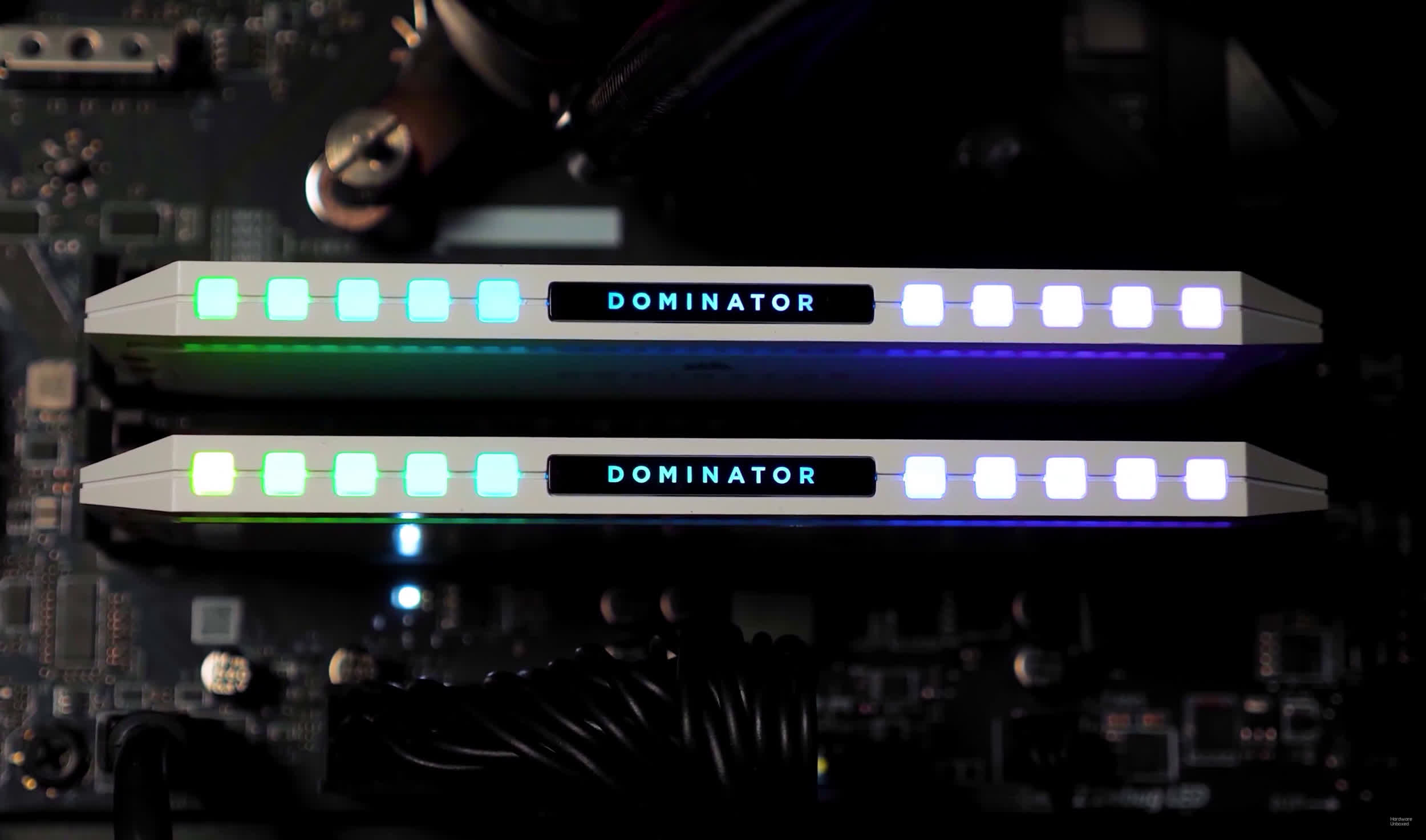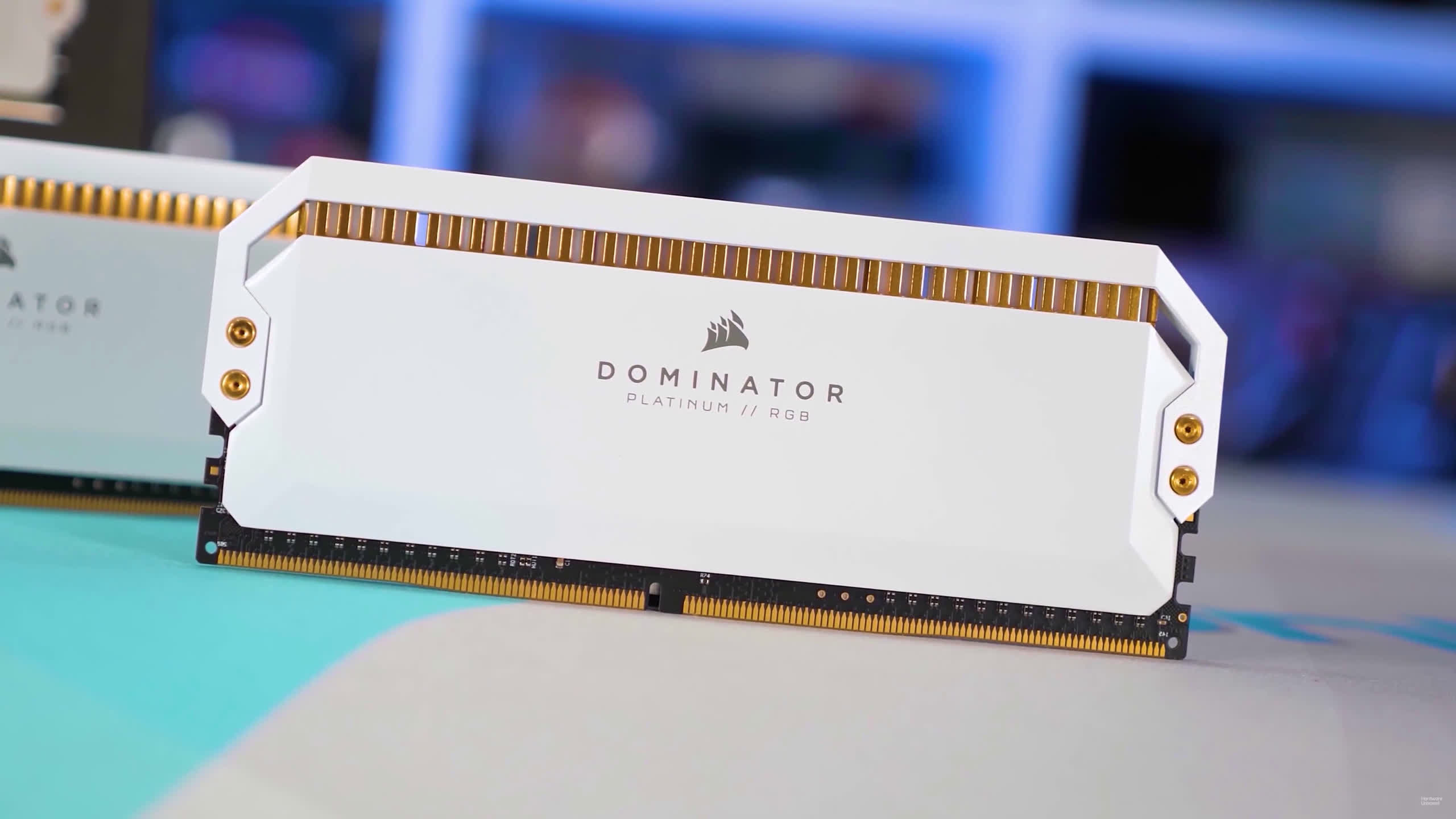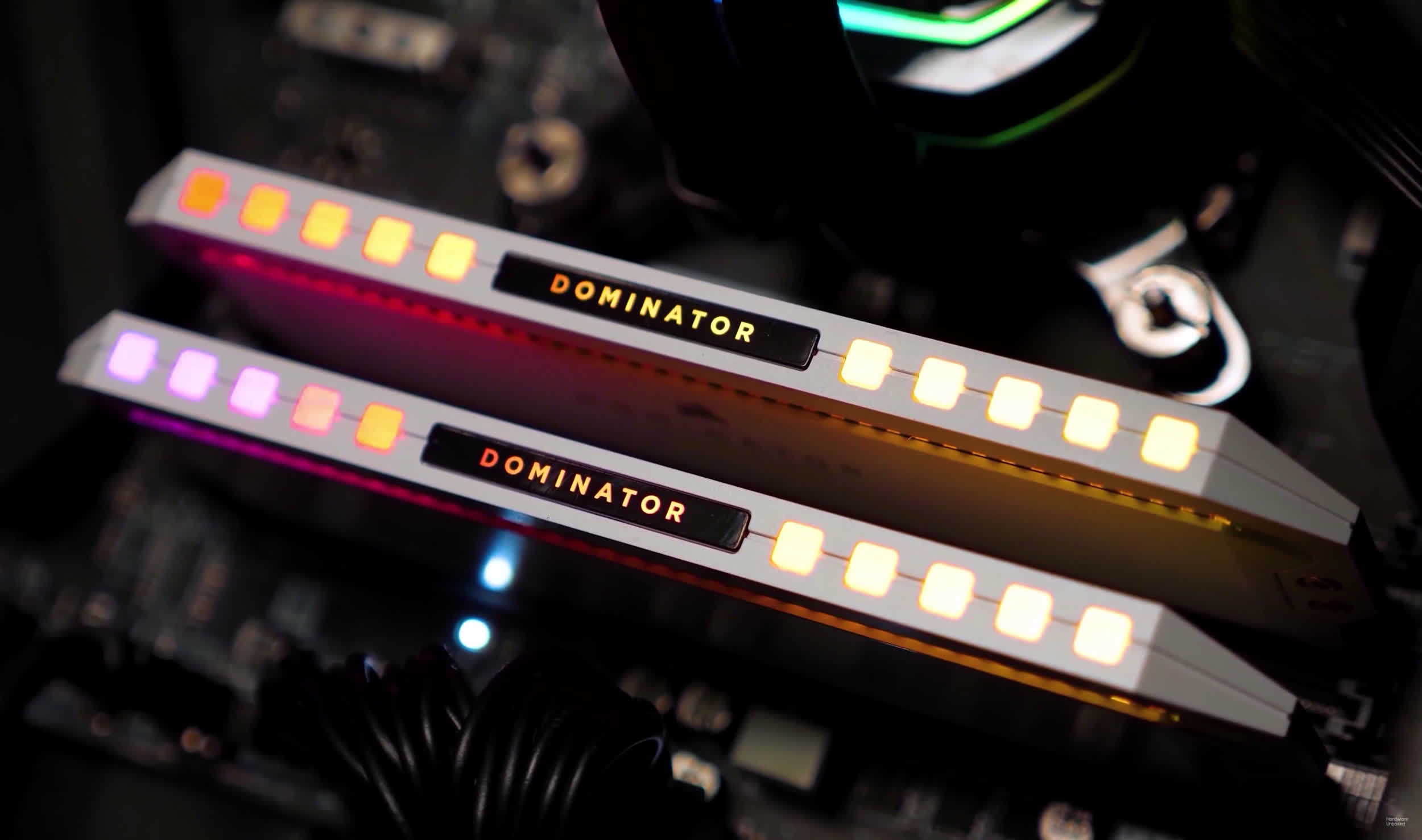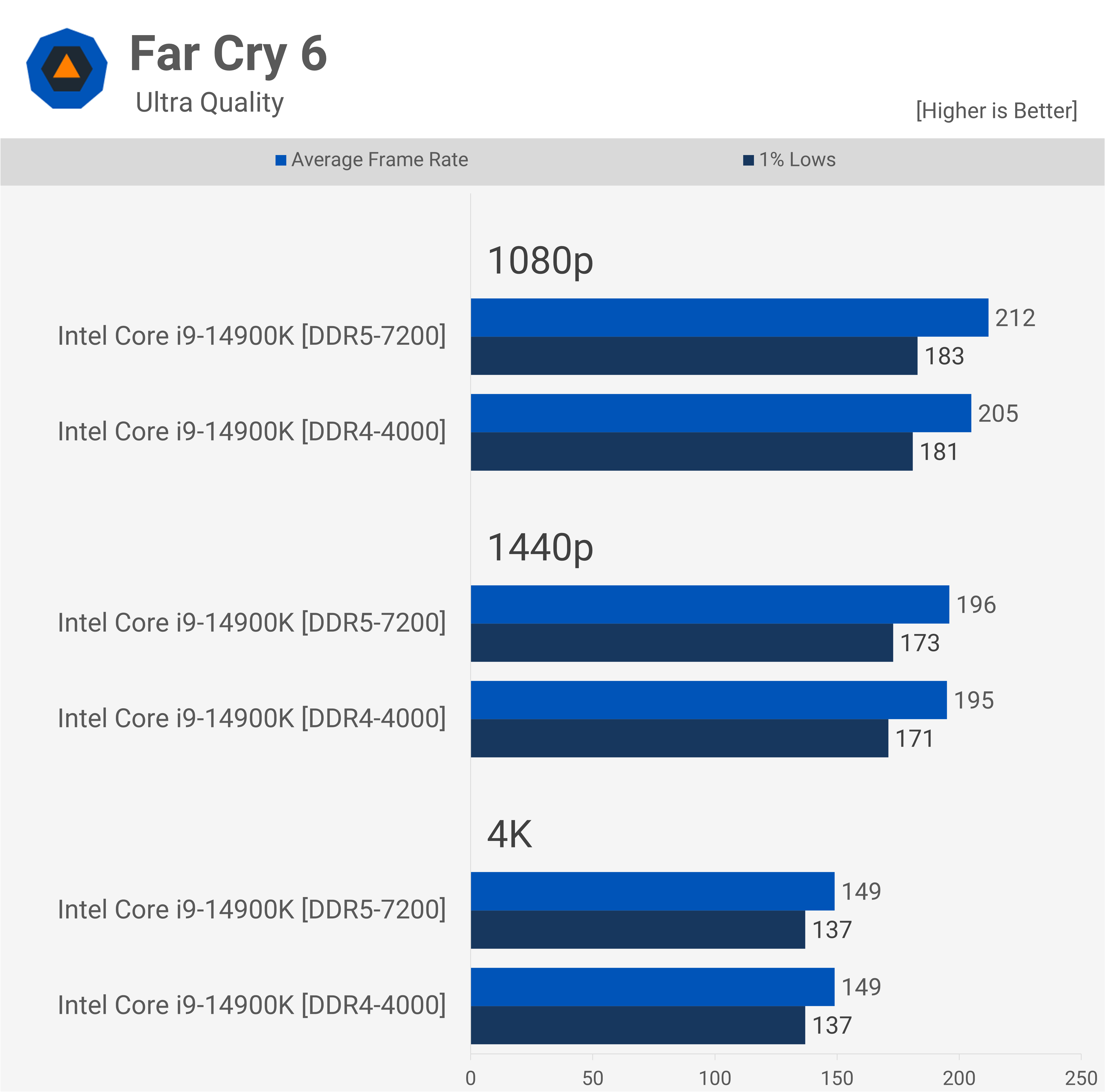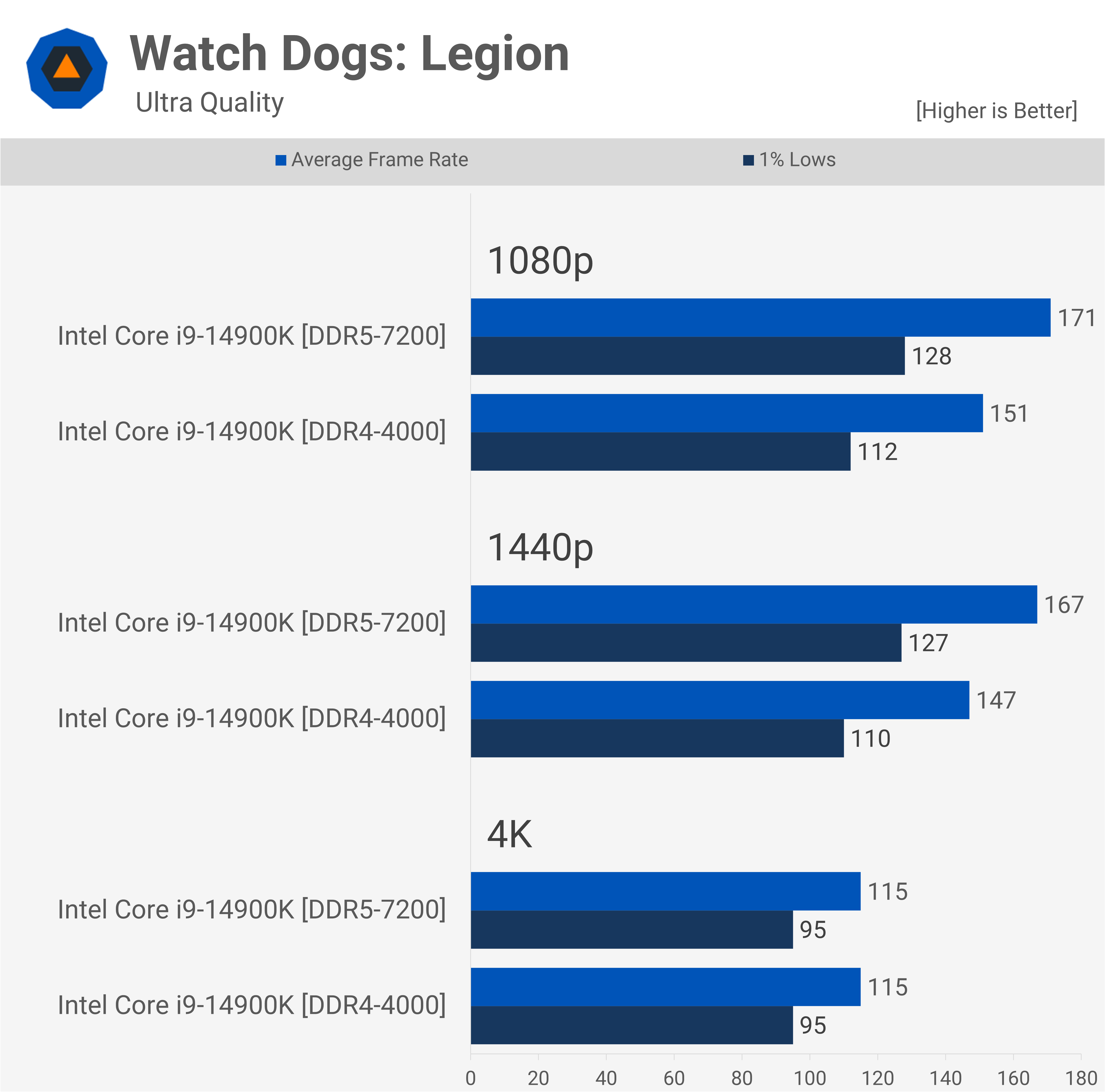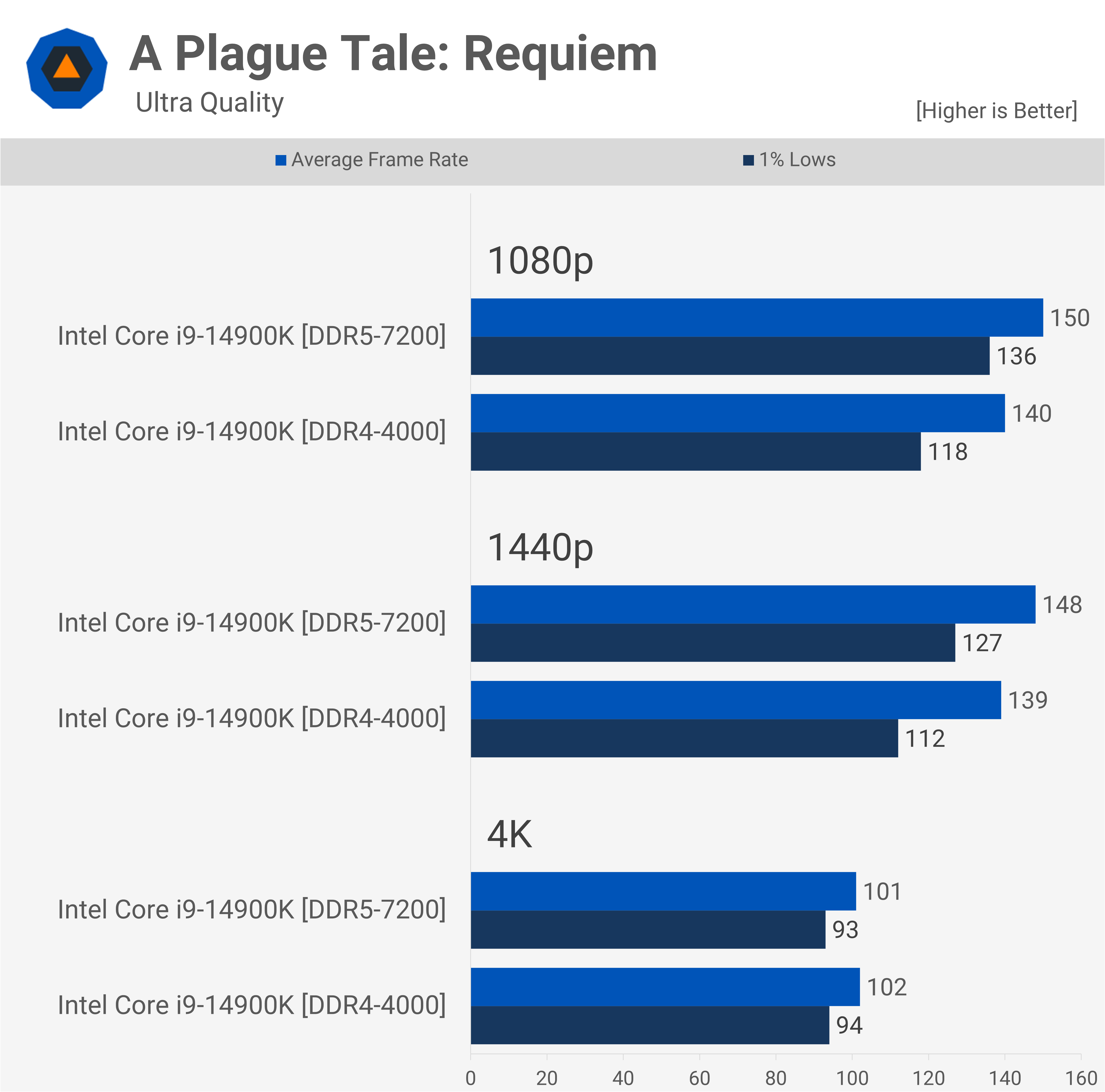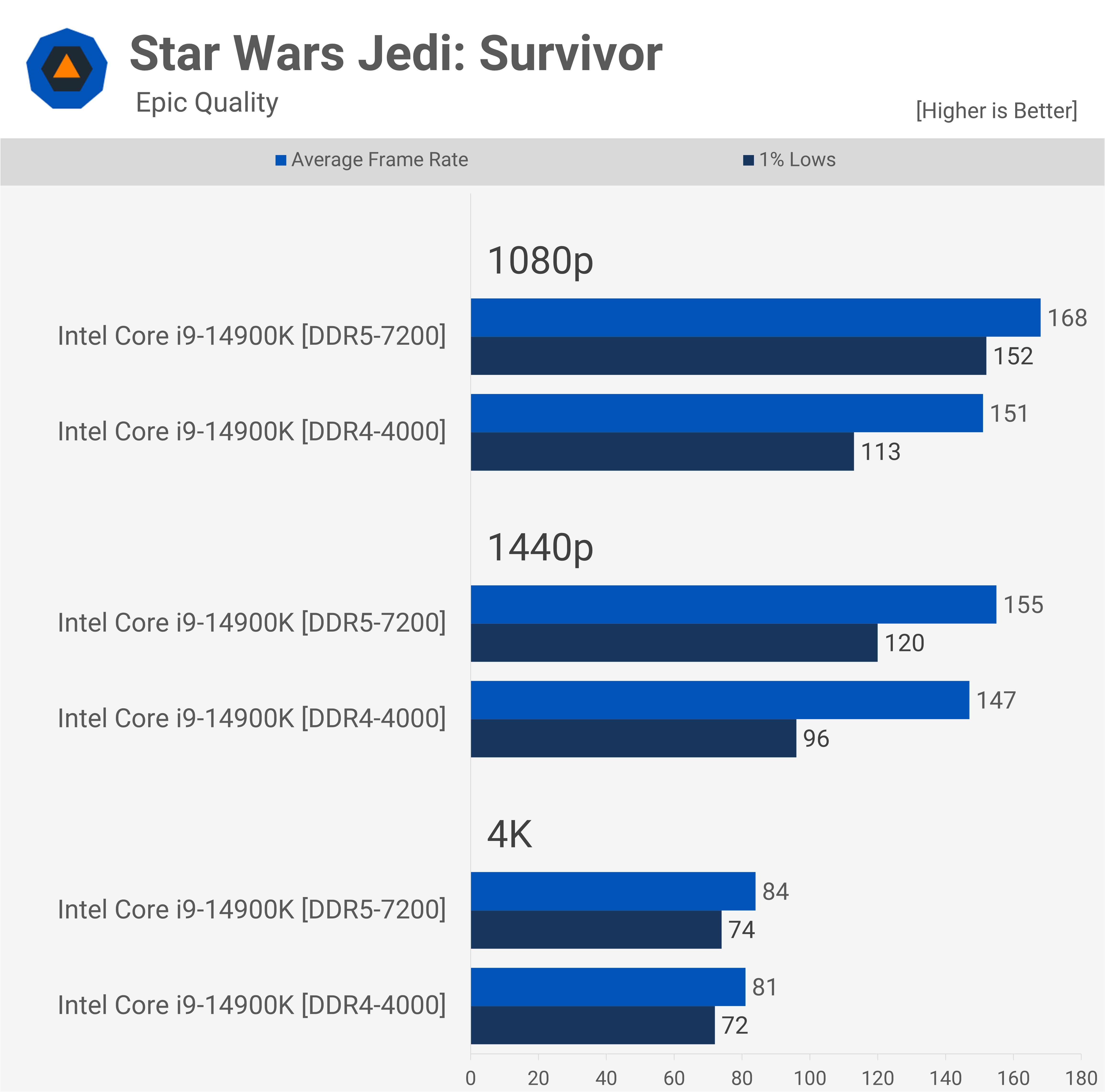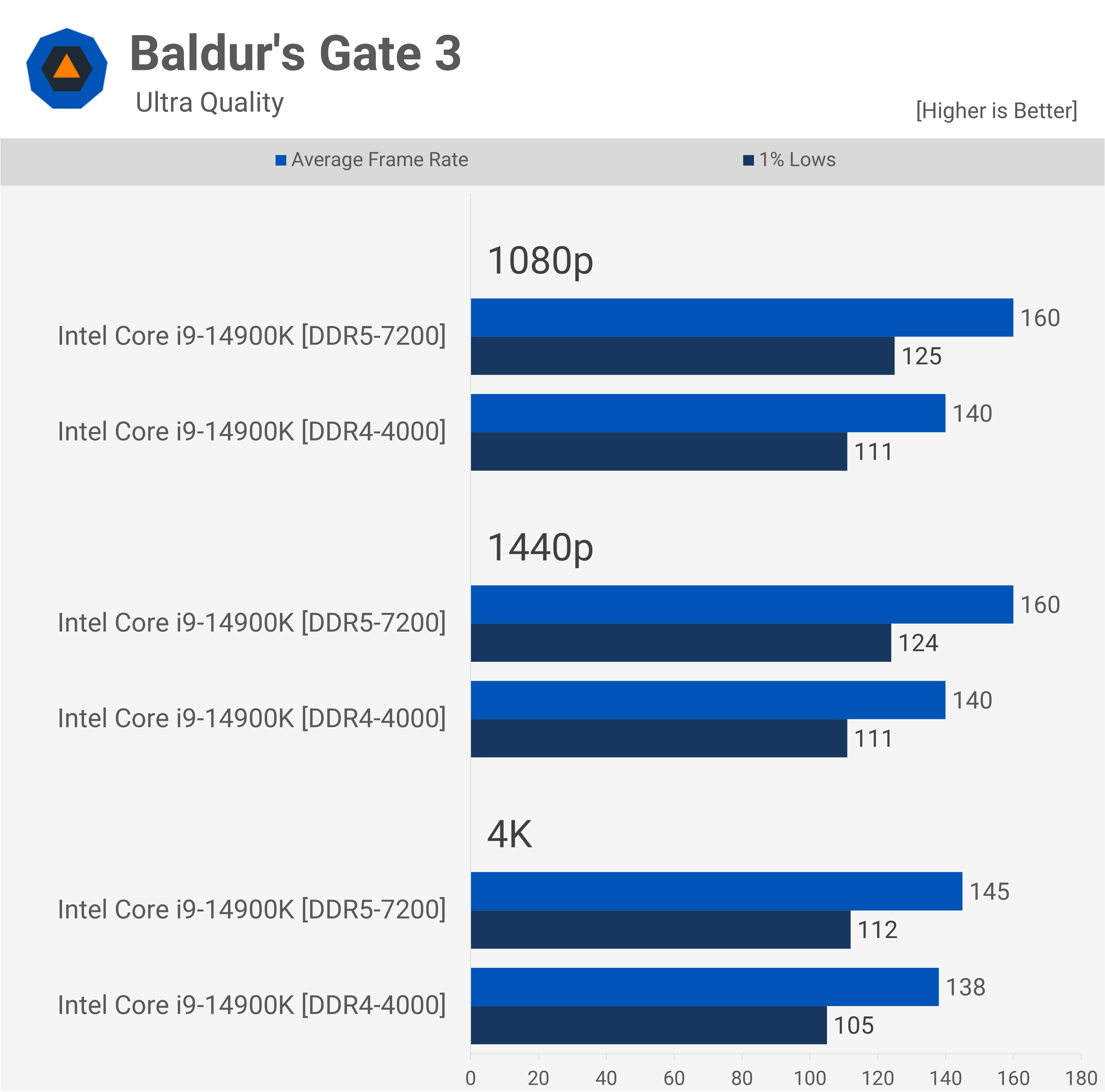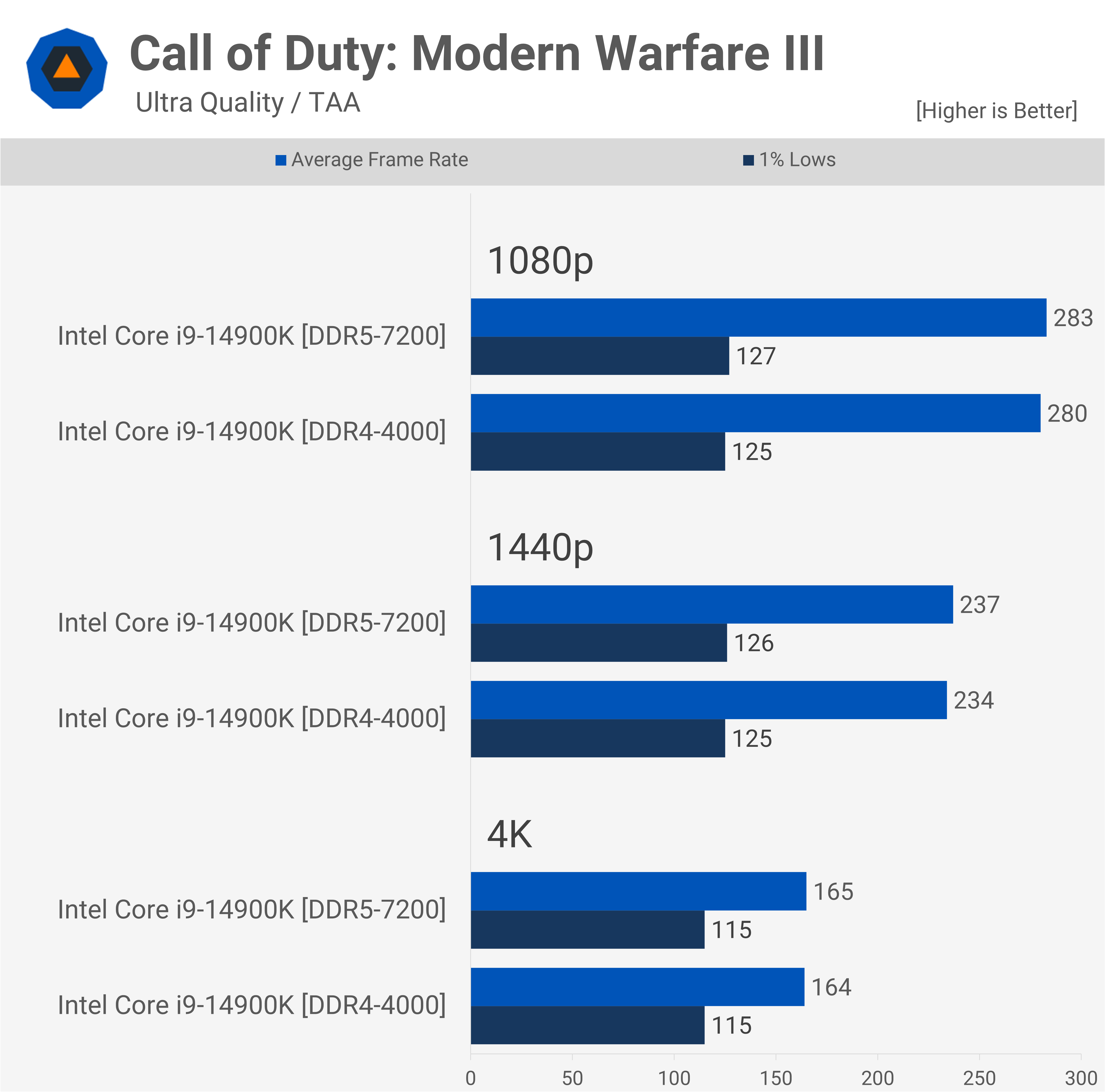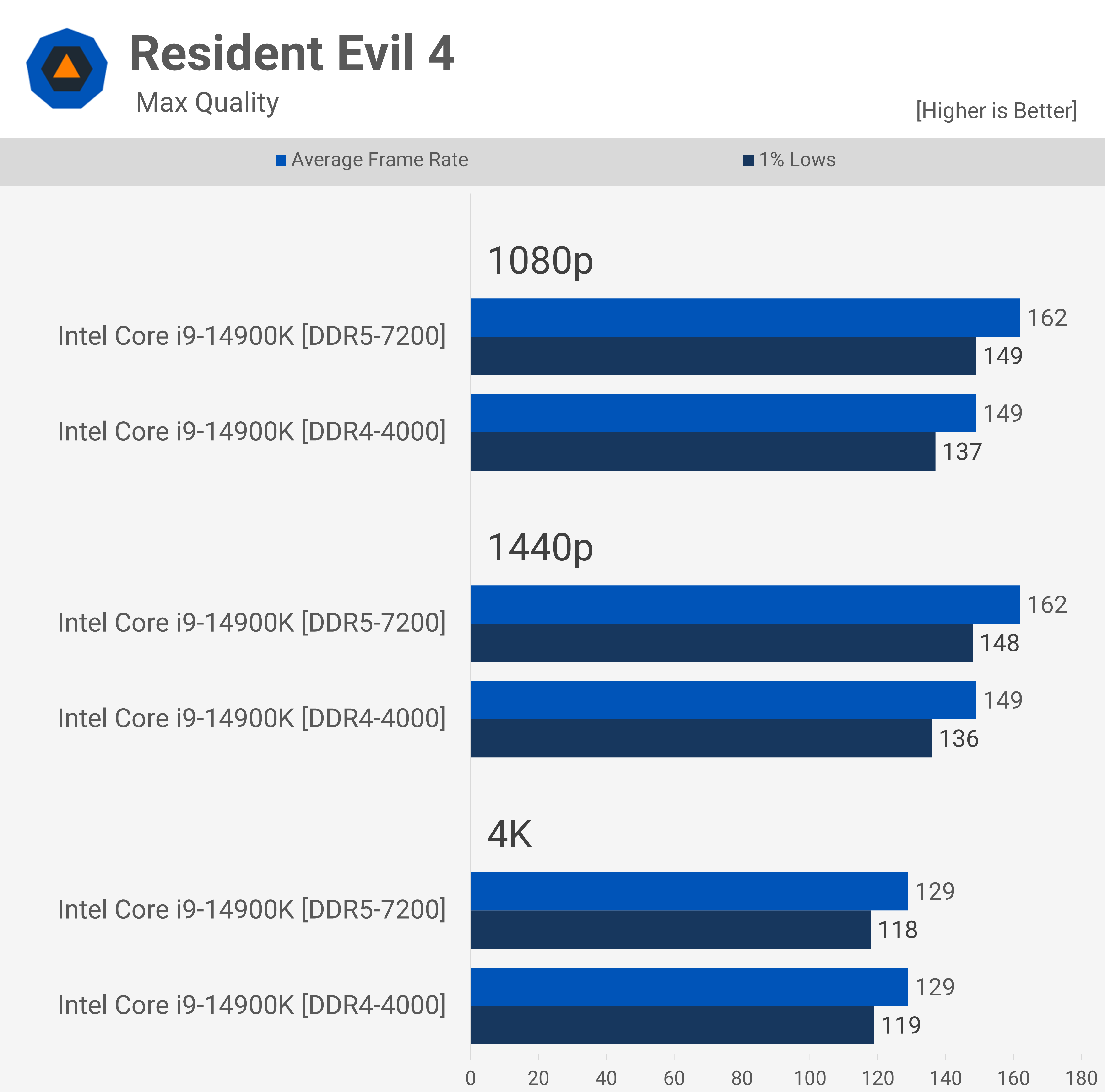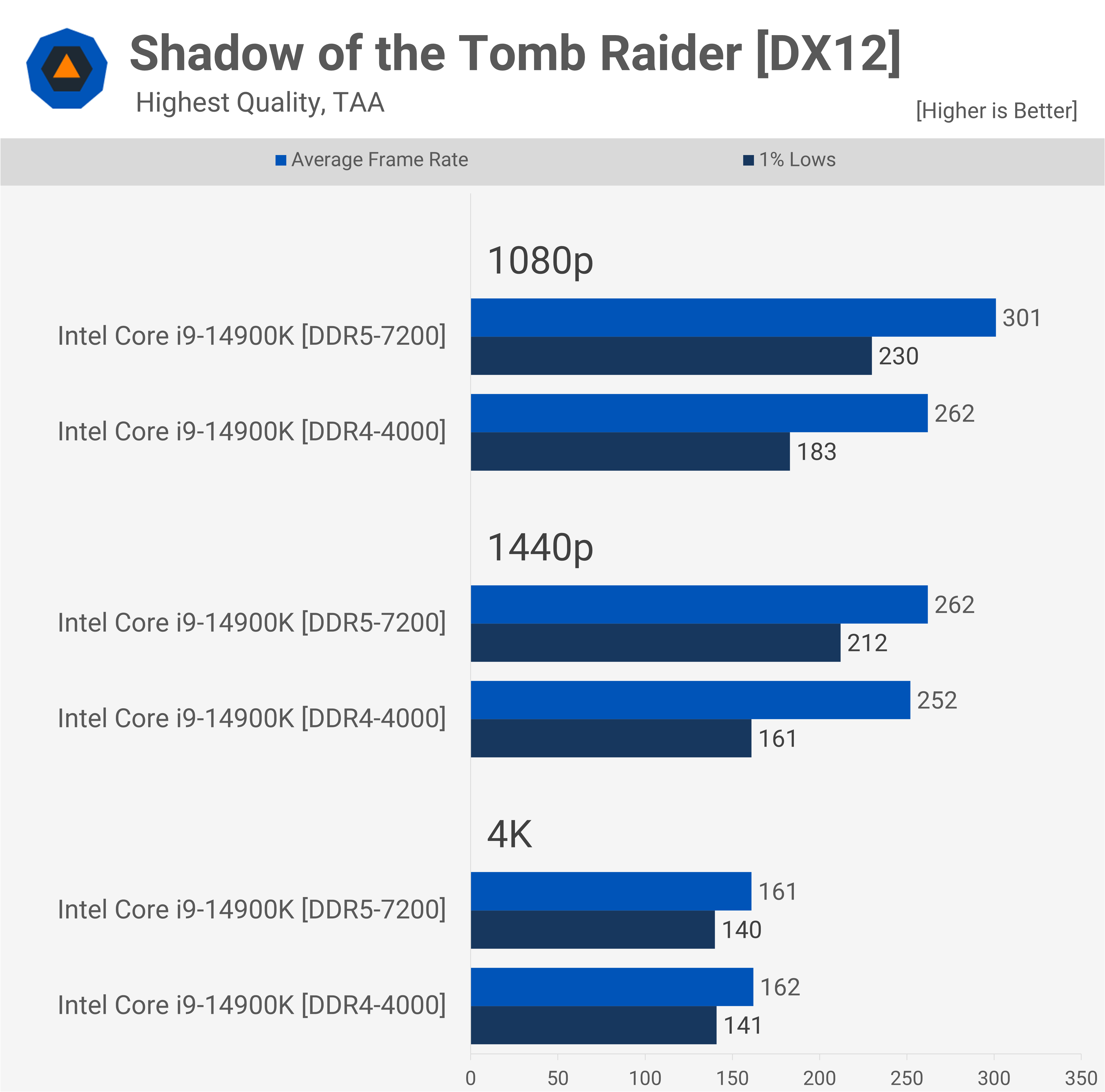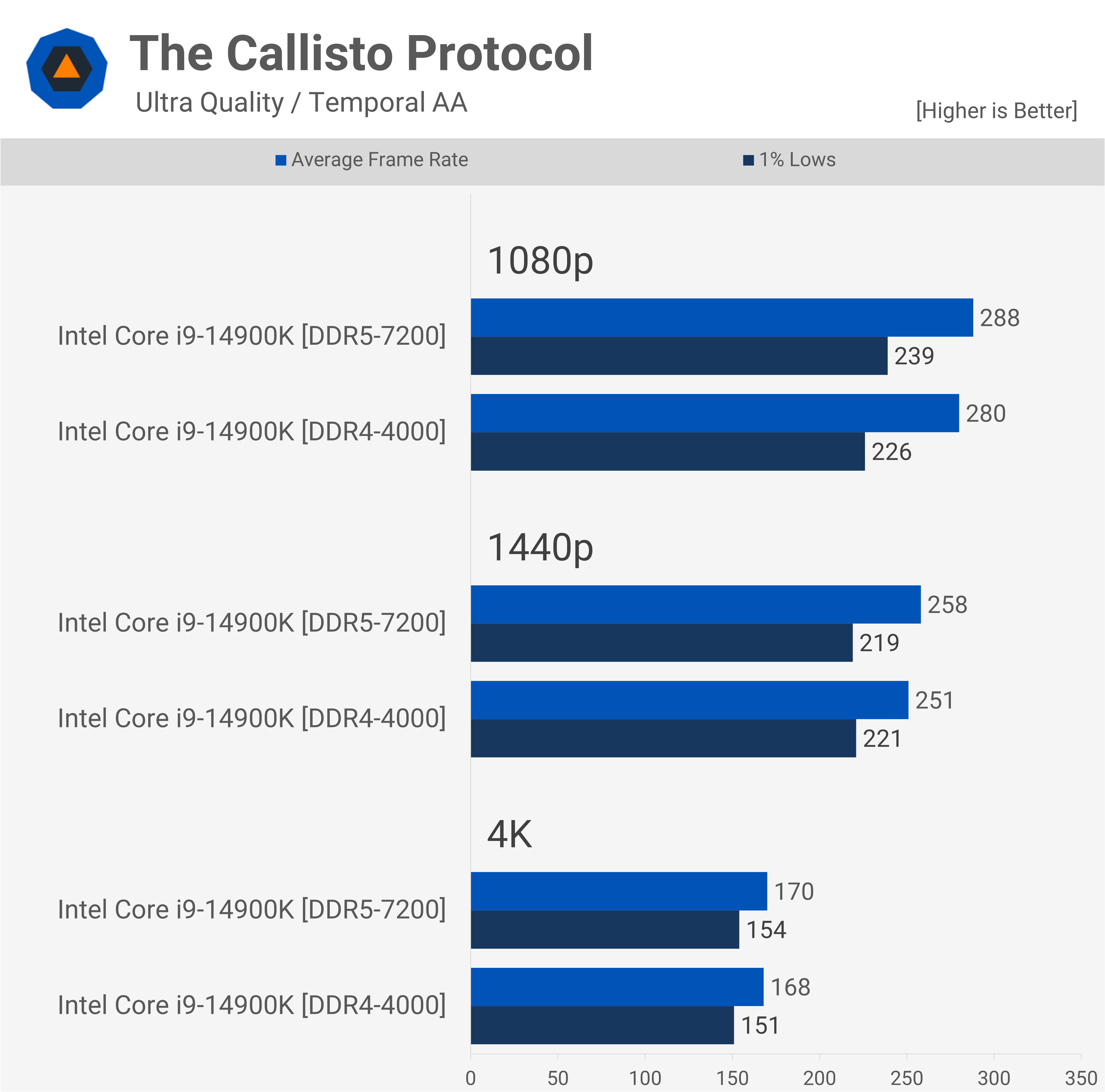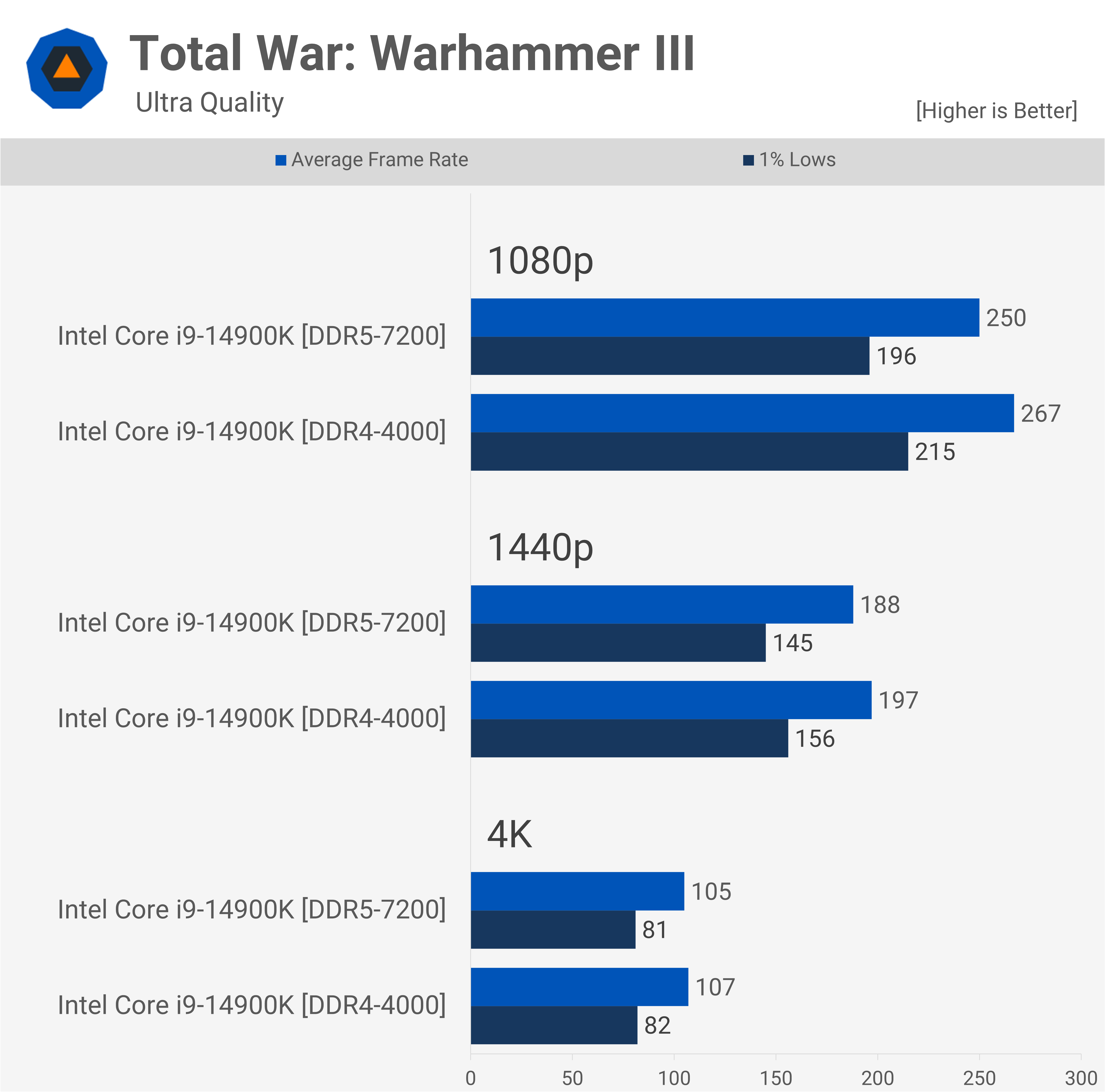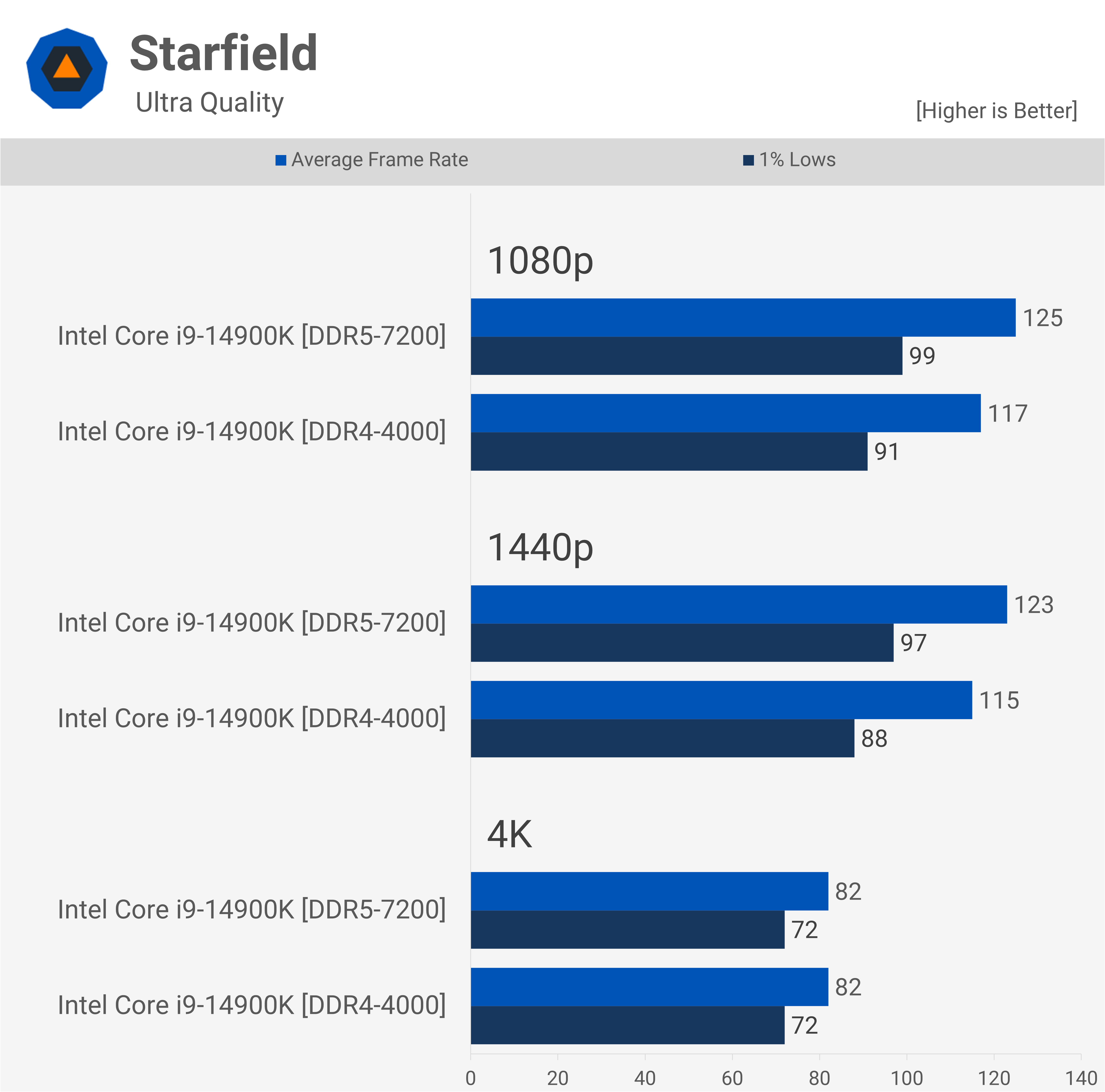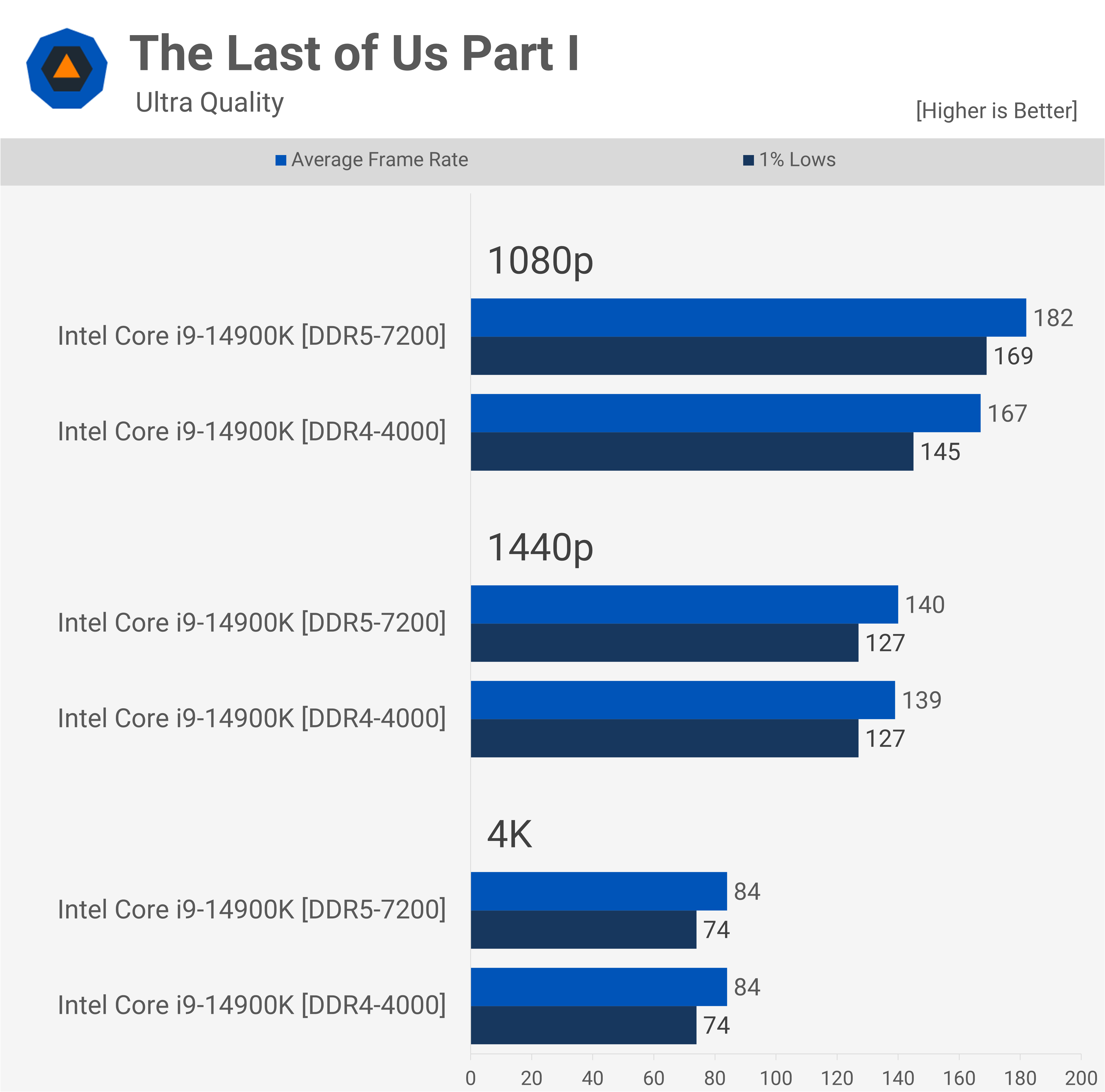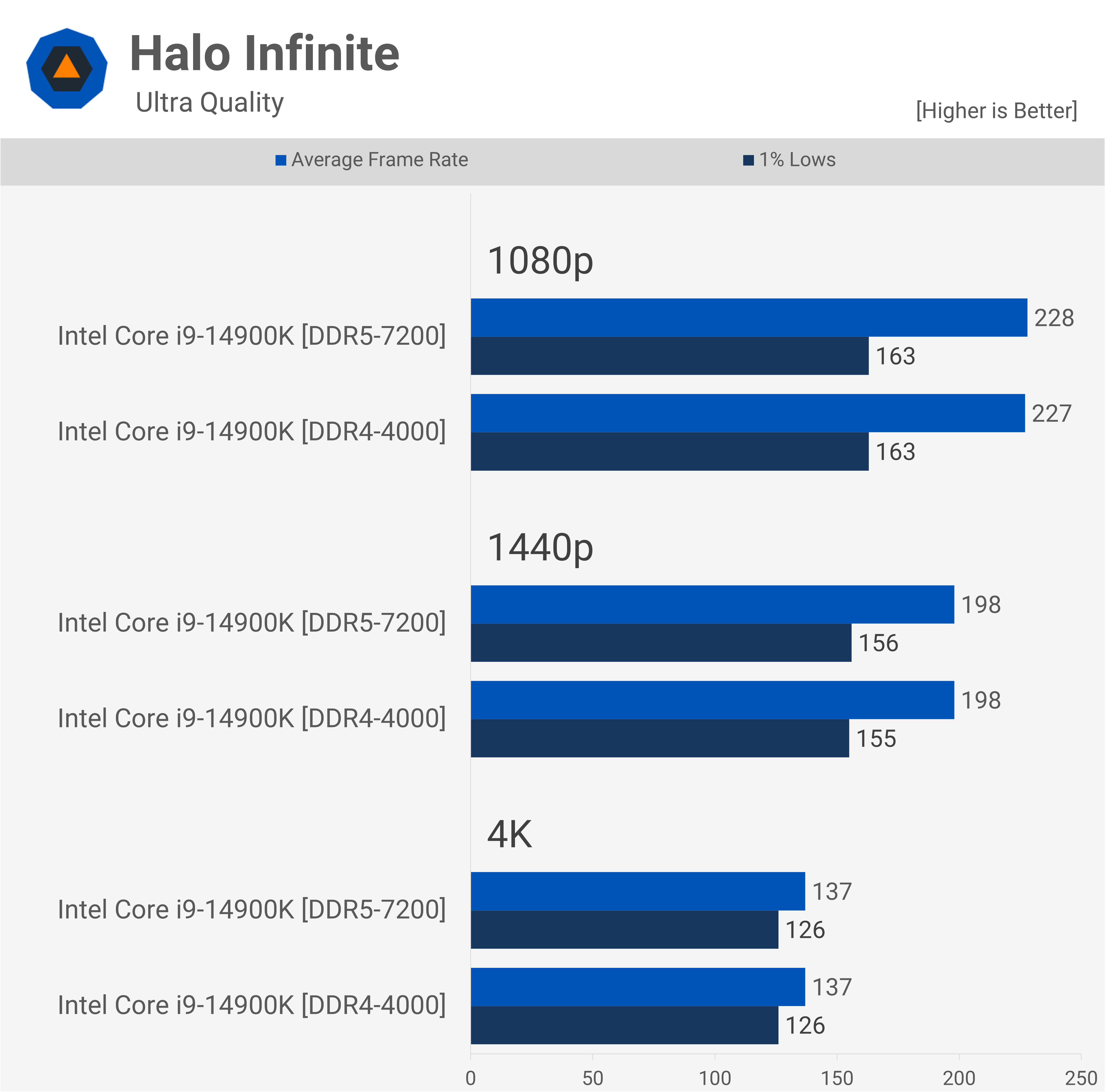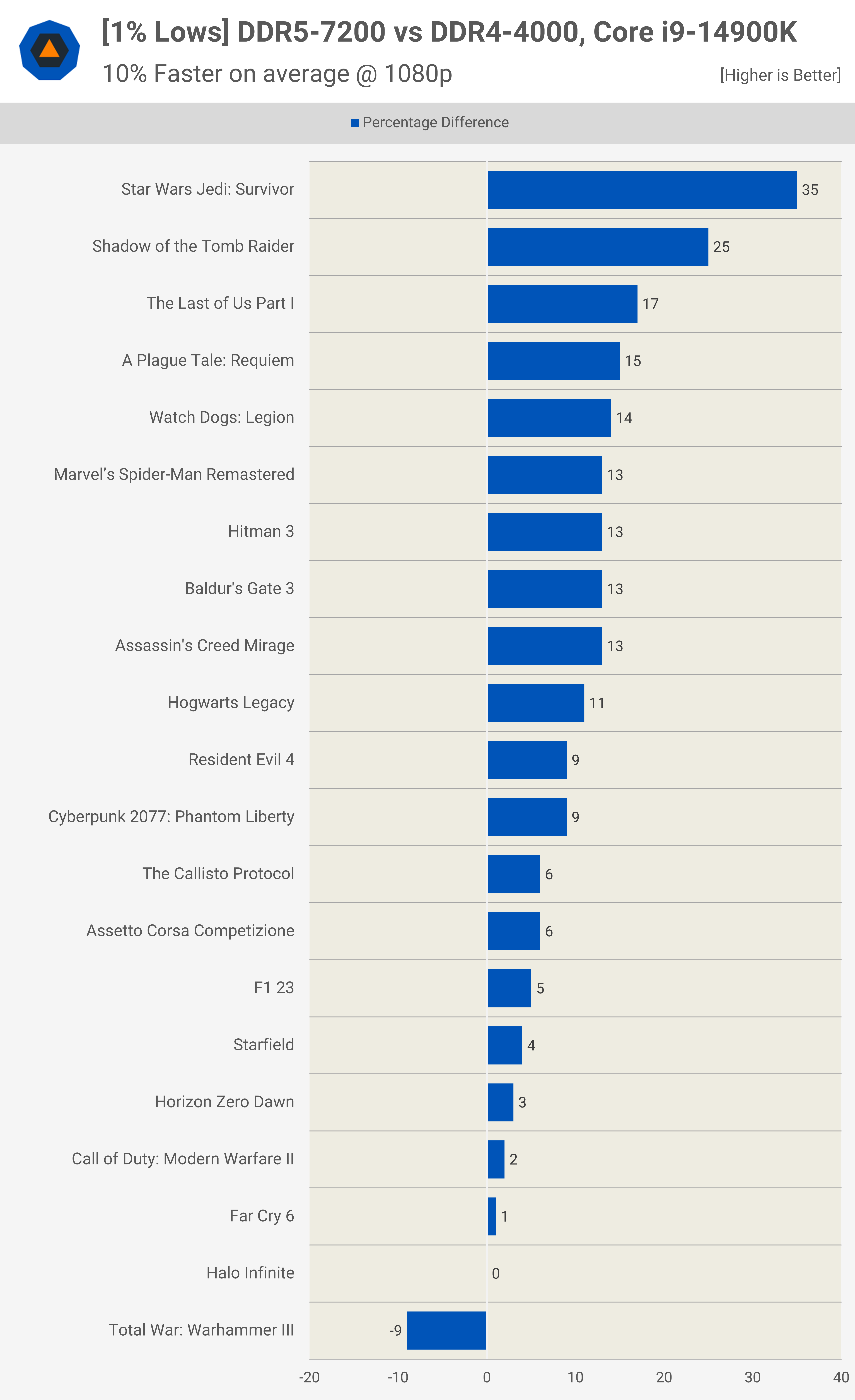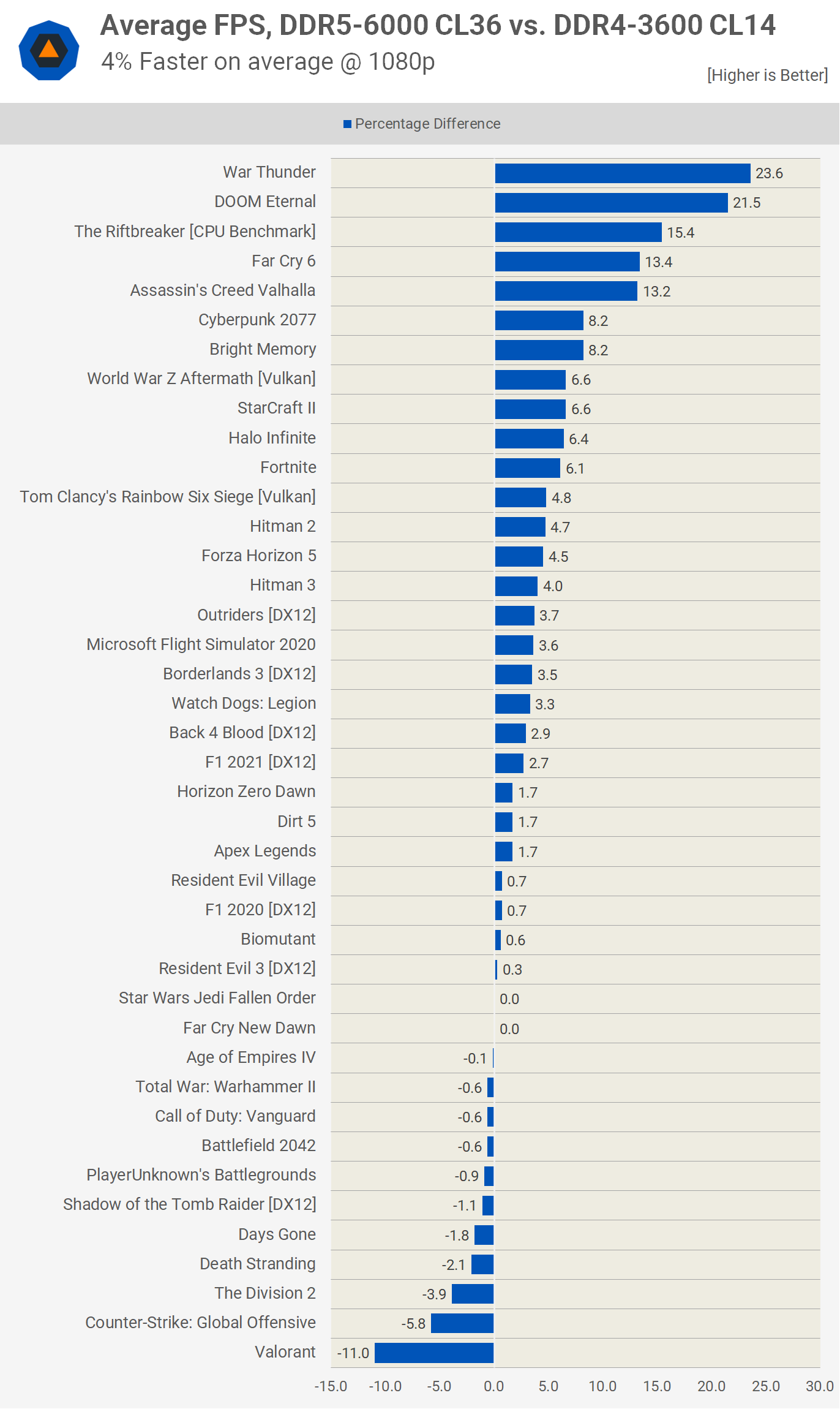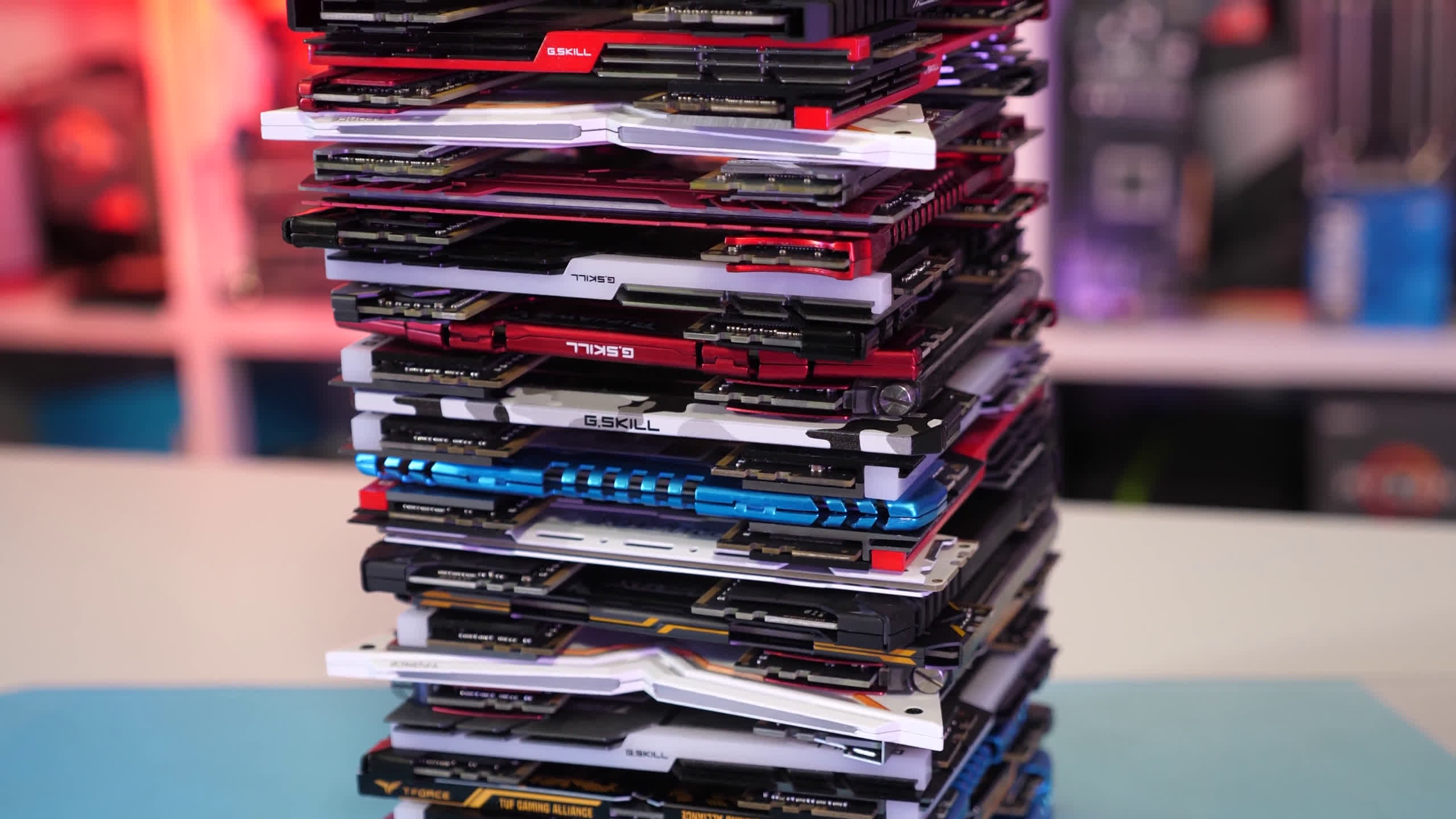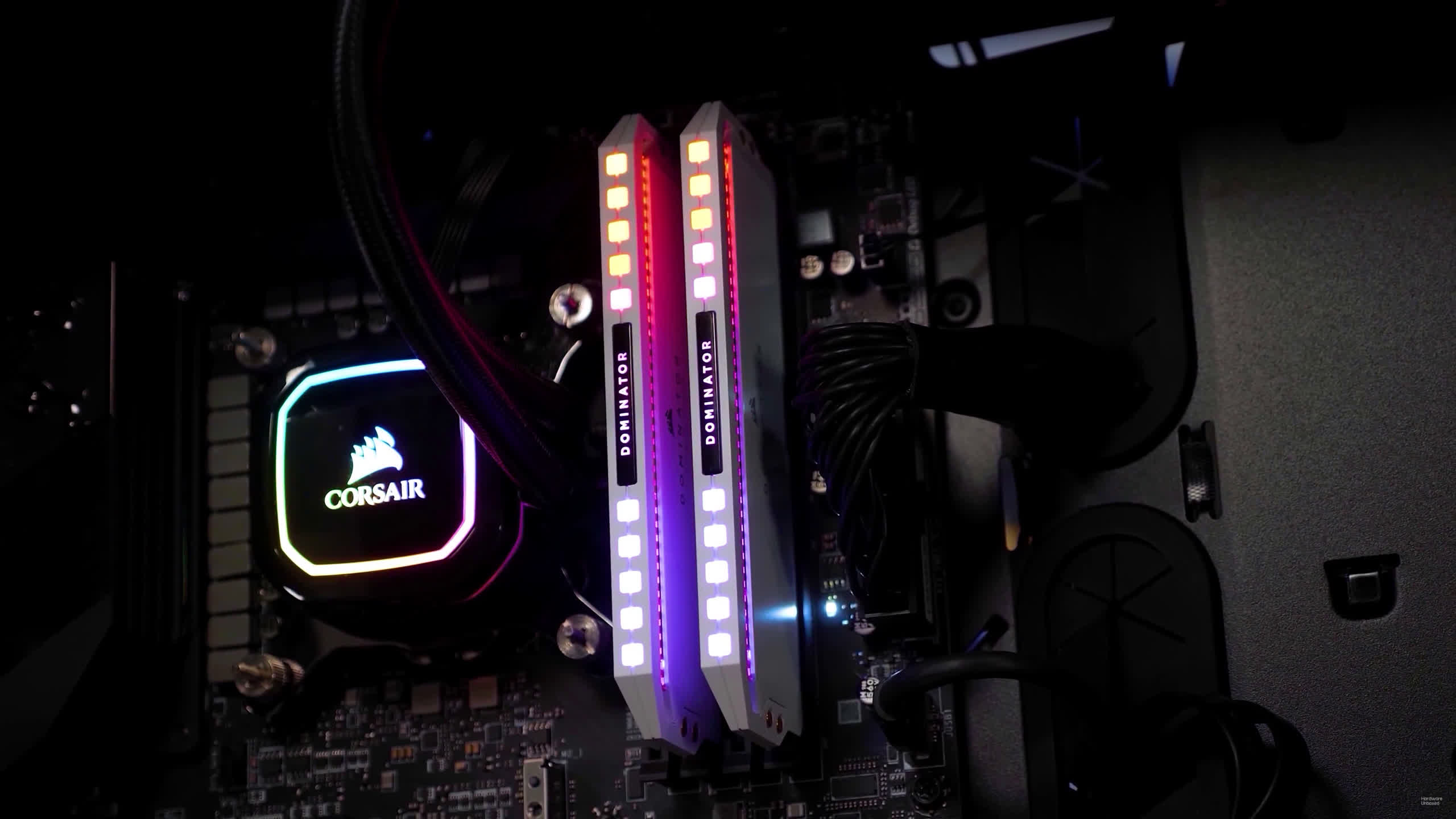It's time we take a fresh look at DDR4 vs. DDR5 memory, using the "new" Intel Core i9-14900K. The last time we compared DDR4 and DDR5 memory was nearly two years ago using the i9-12900K in 41 games. At the time, we were using DDR5-6000 and DDR4-3600 for testing but today we're upgrading that to DDR5-7200 and DDR4-4000 memory.
Interestingly, in a role reversal, DDR4 memory now costs quite a bit more than DDR5 (!). The G.Skill Ripjaws V Series 32GB DDR4-4000 CL16 kit is priced at $170, while the G.Skill Trident Z5 RGB Series 32GB DDR5-7200 CL34 kit is available for $130.
So this review focuses less on whether you should pair an LGA 1700 processor with DDR4 or DDR5 memory – less about buying advice and more about curiosity – how does DDR4 compare to the newer DDR5 standard in modern games?
For new system builders, the buying advice is quite straightforward: just go for DDR5, as it's generally faster and doesn't cost significantly more. For instance, a 32GB DDR5-5600 kit is available for $70 these days, while DDR4-3600 kits start at around $55. Additionally, both DDR4 and DDR5 motherboards often cost a similar amount, with DDR5 models now being more readily available.
Let's now delve into the performance differences between premium DDR4 and DDR5 memory kits using the Core i9-14900K. With 21 games to review, let's dive in.
Benchmarks
First up, we have Assassin's Creed Mirage, where DDR5 offers up to a 13% greater performance, observed in the 1% lows at 1080p, with a 7% boost to the average frame rate. For reference, we also have some 1440p and 4K data. However, as we become more GPU-limited, CPU memory performance plays a less critical role.
If this were a game where around 200 fps was required, DDR5 would provide the best chance of hitting that target, even with a lower-end GPU, as the graphical quality settings could be adjusted.
Cyberpunk 2077: Phantom Liberty isn't highly memory-sensitive. A noticeable advantage with DDR5 emerges at higher frame rates. At 1080p, the DDR5-7200 configuration was 9% faster.
Horizon Zero Dawn performs similarly with either DDR4-4000 or DDR5-7200 memory, effectively utilizing the Core i9-14900K.
Far Cry 6 shows little reliance on memory performance, yielding similar results for the 14900K using either DDR4 or DDR5 memory.
F1 23 is not particularly memory-sensitive, and thus, we observe little to no difference between DDR4 and DDR5 in this example.
In Assetto Corsa Competizione, average fps performance saw a minor increase with DDR5, moving from just over 160 fps with DDR4 to just over 170 fps using DDR5. While not a noticeable difference, DDR5 enables the highest level of performance in this title.
Watch Dogs: Legion, a CPU-demanding title, benefits from the increased bandwidth of DDR5, enhancing performance by up to 14% at 1080p, with significant gains also noted at 1440p.
In A Plague Tale: Requiem, DDR5 was on average 7% faster, with more substantial margins in the 1% lows. Here, DDR5 was up to 15% faster, especially at 1080p.
The Star Wars Jedi: Survivor results show an extreme difference in the 1% lows. At 1080p, DDR5 was 11% faster on average, but the 35% margin in 1% low performance is more pronounced. The margins at 1440p are also significant, though performance becomes more GPU-bound at 4K.
DDR5 significantly enhances performance in Baldur's Gate 3, offering a 20 fps increase at both 1080p and 1440p. This equates to a notable 14% improvement, consistent in both average and 1% low metrics.
Call of Duty: Modern Warfare III seems to perform well using DDR4 memory, with no significant difference noted between the two memory standards.
In Resident Evil 4, we're observing a notable 9% performance boost at 1080p and 1440p. Beyond that, the results become predictably GPU-limited at 4K.
Shadow of the Tomb Raider, though aging, remains a CPU-demanding game. Consequently, we're witnessing a considerable performance discrepancy between DDR4 and DDR5 memory, with DDR5 being up to 26% faster at 1080p.
The Callisto Protocol, not being particularly CPU or memory-intensive, allows DDR4-4000 memory to deliver performance comparable to DDR5 at very high frame rates.
The results for Total War: Warhammer III are surprising, as here DDR4 outperforms DDR5, providing up to 10% more performance at 1080p. We have previously encountered scenarios where DDR4 performs better than DDR5, though this is typically in much older games.
In Hogwarts Legacy, where every frame is crucial, especially with ray tracing enabled, the 9% performance boost provided by DDR5 is significant, increasing frame rates from 70 fps to 76 fps. This margin is also evident at 1440p.
Given Starfield's CPU limitations, one might expect a more substantial performance uplift from DDR5 memory. However, at 1080p, we're only seeing a 7% increase in the average frame rate.
Next, we review The Last of Us Part I. Surprisingly, DDR5 didn't have as much advantage over DDR4 as anticipated in this title. However, the gains at 1080p are noteworthy, with 1% lows boosted by 17%, although the average frame rate only sees a 9% increase.
In Halo Infinite, the choice of memory, whether DDR4-4000 or DDR5-7200, didn't impact the frame rates when paired with the 14900K, with identical outcomes at 1080p.
While over 200 fps may not be necessary for playing Hitman 3, DDR5-7200 is the preferred choice for maximizing frame rates, offering a 12% performance improvement at 1080p.
Spider-Man Remastered is known for benefiting from DDR5 memory. Here, we observe up to a 20% performance increase, with the game being heavily CPU-bound, even at 4K, where, interestingly, the largest margin in 1% lows is detected.
Performance Summary
We've now taken a look at the 21 games tested, and as expected, DDR5 generally offers better gaming performance. To quantify this advantage, let's examine the 1080p margins for the average frame rate and 1% lows…
Upon comparing the average frame rate, we found that DDR5 memory was, on average, 7% faster. This isn't a significant margin, though we did encounter several instances of double-digit improvements.
There were, of course, a few games where DDR4 and DDR5 delivered the same or very similar performance, which lowers the overall average. In Warhammer, DDR5 was even 5% slower. However, many of the larger margins were seen in the 1% lows, which we'll explore next.
Comparing 1% low performance, DDR5 was on average 10% faster, with several examples exceeding 15%. Notably large margins were observed in Star Wars: Jedi Survivor and Shadow of the Tomb Raider. Overall, performance was certainly better with the faster memory.
For context, a few years ago, using different memory modules, DDR5 was just 3% faster on average for 1% low performance. However, that comparison included nearly twice as many games, many of which had margins of 5% or less.
What We Learned
Bottom line: DDR5 typically offers better performance in modern titles, especially in delivering stronger 1% lows, likely resulting in smoother frame time performance.
However, if you already have high-quality DDR4 memory, particularly 32GB of it, investing in a DDR4 LGA 1700 motherboard remains a viable option. Performance will still be very good, and realistically, in modern games such as Starfield, Baldur's Gate 3, or The Last of Us Part 1, it's going to be GPU limitations that will be noticeable.
That said, if you're an esports gamer or enjoy competitive shooters with competitive quality settings, CPU limitations might play a factor. As always, it depends on variables like your quality settings, hardware, and the games you play.
Generally speaking, for those building a new PC or upgrading their platform, DDR5 is the preferable choice as it typically delivers the best performance. Nowadays, it doesn't come at a significant price premium, making it a sensible option.
We also anticipate future games to demand more CPU and memory bandwidth, similar to what we see in newer titles like Star Wars Jedi Survivor and Spider-Man Remastered, compared to older games like Far Cry 6. While it's not always the case that a new triple-A title will run noticeably faster on DDR5 compared to DDR4, we're still some way from that becoming a universal trend.
Shopping Shortcuts:
- G.Skill Ripjaws V DDR4-4000 CL16 on Amazon
- G.Skill Trident Z5 RGB Series DDR5-7200 CL34 on Amazon
- Intel Core i9-14900K on Amazon
- Intel Core i7-14700K on Amazon
- Intel Core i5-14600K on Amazon
- AMD Ryzen 7 7800X3D on Amazon
- AMD Ryzen 9 7900X on Amazon
- AMD Ryzen 9 7950X on Amazon
- AMD Ryzen 9 7950X3D on Amazon
